Guy Whose Job Is Putting On Face Paint And Frightening Children Resents Being Compared To Scary Old...
Guy Whose Job Is Putting On Face Paint And Frightening Children Resents Being Compared To Scary Old Man
“The head of Germany’s most prominent circus has criticised Social Democratic candidate Peer Steinbrueck for comparing the clown profession to former Italian prime minister Silvio Berlusconi…. ‘Being a clown is an honorable, very difficult, sensitive and artistic occupation,’ he said. ‘How can you compare that with bunga-bunga?’”
Eels, Orchids, Nick Cave and "Theorizing the Web"
WELCOME TO MARCH, SUCKERS. Hard to believe. Here, we picked out some things for you to do, let us tell you about them.
A Natural History Of The Penis: A Visit To Iceland's Infamous Penis Museum
by Ferris Jabr
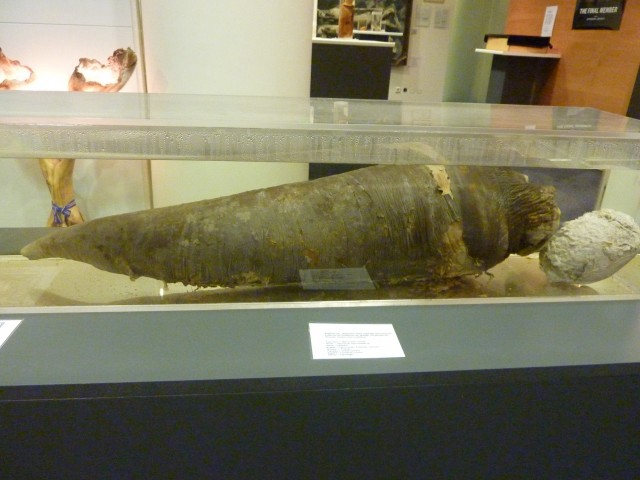
If you haven’t heard of Sigurður Hjartarson by name, you’ve probably heard of his penis… museum. Hjartarson and his son Hjörtur Sigurðsson own and manage The Icelandic Phallological Museum in Reykjavik, which has the world’s largest collection of penises and related artifacts (283 and counting!). This winter I finally got the chance to visit, along with my good friend Mara. My first surprise was how sleek and modern it looked from the outside: large frosted windows with “The Icelandic Phallological Museum” printed in neat type in various languages, almost in the style of commemorative glass plaques. From a distance, one might mistake the building for an art gallery or office space, if not for the large silver sign that features what is perhaps the most forthright museum logo ever devised: a mushroom-capped penis standing at attention in front of a silhouette of Iceland.
Mara and I were the only visitors when we arrived. After paying 1,000 Icelandic krona (about 8 US dollars) each for our tickets, we walked past the front desk, turned a corner and entered the museum’s well-lit main room. We were surrounded. Penises and testicles claimed every available surface — sprouting from the floor, crowding shelves, hanging from the ceiling. One enormous brown phallus drooped from the wall like the schnozz of a Norwegian troll or something melting in a Salvador Dalí painting. Many penises were plump but limp in jars of formaldehyde, floating as contentedly as pickled turnips. A few were as stiff as stone, fixed in eternal erection. It was a quiet and dignified room demanding a kind of sedate reverence: all those specimens carefully arranged, waiting for the monosyllabic expressions of admiration and hushed conversations of passersby. It was, too, a room full of dicks.
I stopped in place, overcome with a unique sense of awe. It reminded me of visiting Six Flags Great America for the first time with my middle-school friends: the sight of all the possibilities before us — the coasters’ colossal slopes, steep drops and gorgeous loop-de-loops — stunned us for a moment, before we bolted into the theme park. Now, older, I reacted more sensibly. Composing myself, I stepped into the room, readied my camera and casually turned toward one of the displays on my left. In a glass jar about four times larger than a standard jar of jam, a fat grey organ curled in on itself like an elephant’s trunk. Its slightly wrinkled skin pressed right up against the glass. I took a picture. A laminated piece of paper informed me that this was the penis of a sei whale, which is among the larger species.

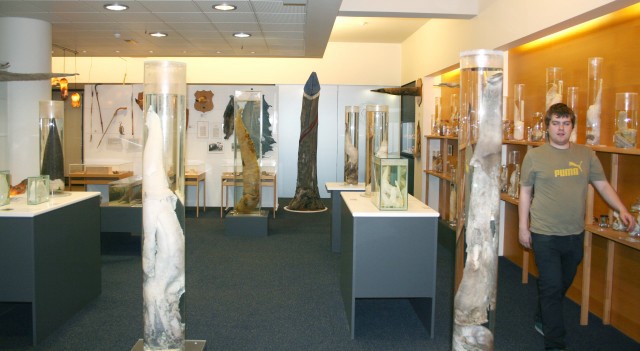
In the museum’s marine mammals section.
(This photo and the one above courtesy of the Icelandic Phallological Museum.)
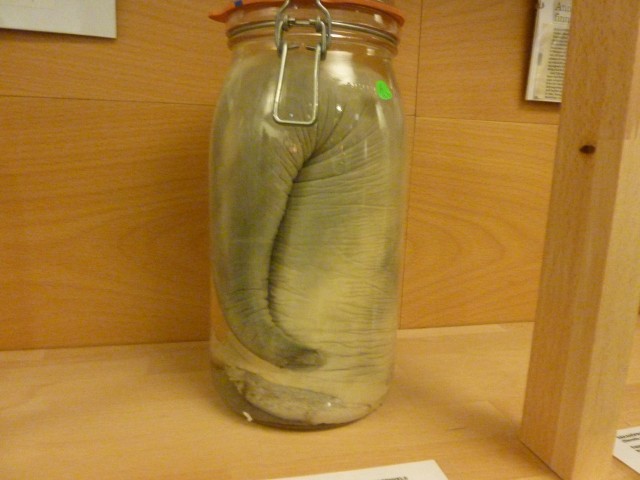
A sei whale penis in a jar.
In a refreshing contrast to many museums, the Icelandic Phallological Museum completely lacks any pretense or stuffiness. The museum is honest about its purpose: this is a place to come and marvel at a great many penises of different shapes and sizes. Compared to most natural history museums, however, it’s a little light on information. All the specimens are paired with pieces of paper listing the Latin and common names of the relevant animal, and the museum’s website has a thorough catalogue recording the provenance of all the penises in the collection. One of three nooks toward the back of the museum houses a small library. Beyond that, however, there are no panels, videos or exhibits to further stimulate guests. You must be your own guide through this wonderland of phalluses.
To my right, in a tank of clear fluid, rested what looked like an enormous rotting daikon root. A thin sleeve of soot-colored skin had peeled away in places, the way a potato’s skin starts to slip off if you boil it long enough. Next to the bulbous shaft sat a single testicle, which resembled an ostrich egg with a mozzarella texture. It used to sit cozy inside a sperm whale.
In a phone interview, Hjartarson told me that the museum boasts a penis from every kind of mammal now living in Iceland. Nearly half of the penises in the museum once belonged to sea mammals, such as whales, dolphins, seals and walruses, most of which were caught in the waters surrounding Iceland. Covered in glaciers, lava fields and deserts, the mainland is not exactly teeming with terrestrial wildlife. Iceland has no native amphibians or reptiles and fewer than 90 breeding bird species, the most famous of which is the adorable puffin, which looks like a hybrid of a penguin and toucan. When people first colonized the island, probably sometime in the 800s, the only native mammal was the Arctic fox. Today, Iceland is home to sheep, cows, goats, horses, dogs, cats, minks and mice among other mammals, all brought to the island by people in various deliberate and unintentional ways.
A few more exotic peckers have come to the museum as well, most of which are displayed in a nook known as the “foreign section.” Through friends, Hjartarson’s son Hjörtur Sigurðsson acquired the penis of a giraffe that was shot by an Icelander in Namibia in April 2012. In 2001, an Icelandic engineer sent Sigurðsson and Hjartarson the penis of an old male elephant gunned down near a sugarcane plantation in South Africa. In 1993, after some fishermen accidentally killed a cantankerous polar bear that had wandered from Greenland onto Iceland’s western fjords, a natural history museum got the skeleton — including the bear’s penis bone — but Hjartarson got the penis itself. “No animal was ever killed for me or because of me,” Hjartarson says.
AND THEN ONE DAY YOU WAKE UP OWNING A PENIS MUSEUM
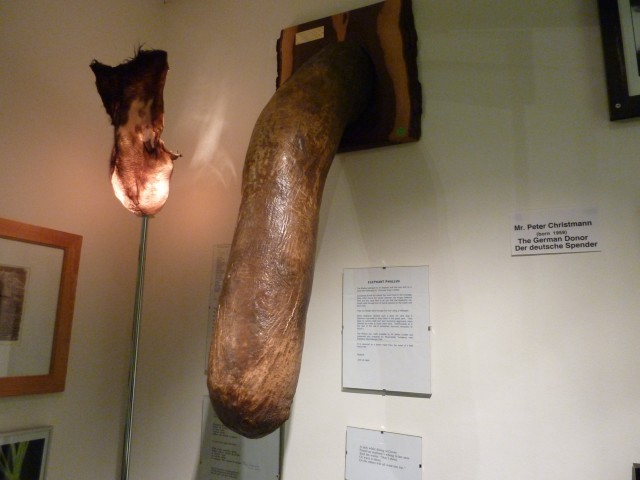
An elephant penis, preserved.
Taking the life of an animal solely to acquire its reproductive organs would betray the spirit of the museum. The whole thing started as a joke among friends. In the 1970s, Hjartarson was the headmaster of a school in Akranes, a port town in southwest Iceland. One day, over drinks, he and some teachers got to talking about ancient Icelandic traditions — in particular the tendency to use every part of a slaughtered animal. The conversation surfaced a memory in Hjartarson’s mind: as a young boy, his relatives had given him a pizzle — a bull’s penis twisted and fashioned into a cattle whip. When Hjartarson related the memory, one of the teachers said that he was traveling to his hometown to help slaughter some bulls and offered — mostly in jest — to bring back their penises. Hjartarson thought it was a great idea.
At first, he was not sure what to do with his gifts. He tried hanging them out to dry like laundry. People in Akranes started talking; some neighbors mistook the penises swaying in the wind for rhubarb. Eventually Hjartarson decided to have a few of them tanned and others stretched and affixed to plaques, keeping them somewhat more discreetly in his home.
Not knowing much about preserving whale penises between three and eight feet long — or any penis for that matter — Hjartarson tinkered and learned along the way. Sometimes he split the penises open, scooped out everything inside and dried the peel with salt. He experimented with alcohol and formaldehyde.
Hjartarson soon began to receive similar, albeit much larger, gifts from other teachers who spent their summers working at a nearby whaling station. Not knowing much about preserving whale penises between three and eight feet long — or any penis for that matter — Hjartarson tinkered and learned along the way. Sometimes he split the penises open, scooped out everything inside and dried the peel with salt. He experimented with alcohol and formaldehyde. One time he tried filling a penis skin with silicone — a disastrous approach. The skin shrank and expanded when the temperature and humidity changed, but the silicone remained inert, bursting through the delicate membrane.
“The idea emerged gradually that it might be interesting to go on collecting these,” Hjartarson recalled. In addition to accepting donations, he started to actively pursue specimens. He turned to abattoirs for spare parts. He asked a friend in the fishing town of Húsavík to keep on ice the penises of any seals he caught. When he heard about a beached whale on the news, Hjartarson would join the team of scientists traveling to the stranding site and ask if he could take home the penis.
For twenty years, Hjartarson stuffed the swelling multitude of penises into his home and office, taking them with him when he left Akranes to teach in Reykjavik. In 1997, his daughter in law secured a retail space in the center of Reykjavik and, since the space was too large for her purposes alone, she and Hjartarson decided to share it. He knew exactly what he wanted to do with his half.
The same year, Hjartarson officially erected the Icelandic Phallological Museum with penises from 62 different species. “Most people reacted pretty positively,” he said. “When people see there is nothing pornographic in the museum, just these organs, and that we try to put some humor in it, people react very well.”
How did his wife react, I wondered. “She has been supporting me the whole time,” Hjartarson said. “Without her patience and tolerance I would never have been able to do it. I’ve taken specimens into the kitchen to work on them. Some have smelled like hell. She hasn’t liked that as much, but she has tolerated them incredibly.”
The Icelandic Phallological Museum has remained a family affair. When Hjartarson retired from teaching in 2004, he and his wife moved north to Húsavík and reestablished the museum there. In 2011, due to his poor health, Hjartarson passed on management of the museum to his son, Hjörtur, who moved it back to Reykjavik. Lately, Hjörtur Sigurðsson’s 23-year old son has been helping out in the museum as well. Since reopening in November 2011, the collection has attracted more than 13 thousand visitors.
NONE OF THESE PENISES IS LIKE THE OTHER
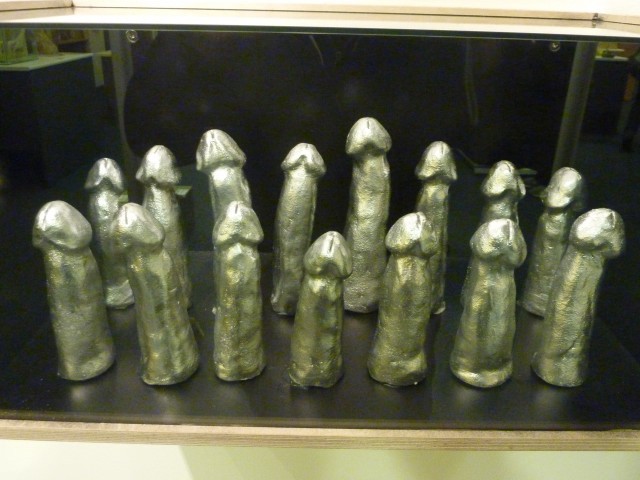
Sculptures of the Iceland men’s handball team.
At the end of a long row of sea mammal penises in jars, a piece of art caught my eye. The museum offers visitors plenty of interesting sculptures, paintings, carvings and tchotchkes to look at, including lampshades fashioned from bull’s testicles and a set of shiny silver penis sculptures, above which hangs a photograph of the Icelandic handball team. Hjartarson’s daughter, Thorgerdur Sigurdardottir, made the sculptures and, as she told Slate, they are not in fact modeled after the members of the Icelandic handball team; rather, she “made them from experience.”
The piece of art that I liked most, however, was a framed poster labeled “The Penises of the Animal Kingdom,” which featured a lineup of erect organs from various mammals, in order from longest (the whale’s) to the shortest depicted (man’s). The poster reflects what is perhaps the museum’s central theme: diversity.
Scientists have learned that the penis is an excellent organ to study precisely because of its diversity. Over the millennia, many different animals in many different environments have depended on their penises to fulfill one half of the most important mission for any living thing — reproduction. In response to this pressure, the penis has adopted an astonishing variety of forms. Penises first evolved in the ocean, where they pioneered a sexual strategy known as internal fertilization. Instead of spraying his sperm into the currents and hoping that some of them hooked up with a female’s deposited eggs — the way that many fish still go about it — a male animal with a penis could shoot his sperm directly at a female’s eggs while they were still inside her body. She, in turn, gained more control over which suitors had access to her eggs in the first place.
Modern penises come with all kinds of frills and accoutrements, like bristles, barbs, foreskins and multiple heads (some marsupials have forked penises; the echidna’s penis has four heads). Some penises engorge themselves with blood or lymph fluid; others rely on a mineral bone to get a boner (in fact, humans are one of the only primates without a penis bone).
Penises have evolved independently several different times in different groups of animals, often as modified forms of existing body parts, such as fins. In all likelihood, the earliest penises were relatively simple and undecorated tubes, perhaps resembling the stout shaft of the 425-million-year-old shrimp-like Colymbosathon ecplecticos — the oldest fossilized penis ever discovered. Some animals still rely on rather modest penises, but many others developed far more complex and ostentatious organs.
Modern penises come with all kinds of frills and accoutrements, like bristles, barbs, foreskins and multiple heads (some marsupials have forked penises; the echidna’s penis has four heads). Some penises engorge themselves with blood or lymph fluid; others rely on a mineral bone to get a boner (in fact, humans are one of the only primates without a penis bone). When erect, penises might be rather stiff and inflexible, or — as in the case of whales and dolphins — retain a rubbery agility. Some penises are unexpectedly small for an animal’s overall size, such as the gorilla’s typical nubbin (1.25 inches erect on average). Others are astoundingly large: the humble barnacle claims the longest penis relative to body size of any animal. A sedentary creature, the barnacle probes for a mate with its impressive penis, which can be eight times its own length .
The duck’s phallus is a particularly rousing example of extreme penis adaptation. 97 percent of bird species do not have penises. Ducks not only have penises — they have long, spiraling ones that burst forth from within their bodies. These elaborate phalluses most likely evolved through sexual conflict. Male ducks are notorious rapists. To combat these unwanted advances, the females have evolved labyrinthine vaginas that twist in the opposite direction of the males’ corkscrew penises. These vaginal passages are filled with spongy pockets with which the females might sop up and expel unwelcome sperm. In retaliation, the males evolved longer, larger and more tightly coiled penises. The penis of the Argentine Blue-bill duck, for example, can stretch to twice its body length when erect. Still, only three percent of duck rapes result in viable offspring.
PRESERVE YOUR PENIS, LIVE FOREVER
After getting a good look at most of the animal penises in the museum, I walked into the folklore section, where I encountered specimens from creatures that are complete strangers to science. According to surveys conducted over the years, between one quarter and one third of Icelanders currently believe in the existence of “hidden folk” and elves. Icelandic myths and legends include an even more varied cast of specters and ghouls. The museum’s folklore section, however, is not really concerned with telling these tales to visitors.
To get a sense of what this particular nook is like, imagine going to an exhibit about American tall tales and, instead of watching a heartening video about Paul Bunyan and his dear companion Babe the Blue Ox — or leafing through beautifully illustrated books about Davy Crockett and Johnny Appleseed — you encounter nothing but glass cases that display what are, ostensibly, these heroes’ penises. Somehow, the Icelandic Phallological museum has managed to acquire the kelp-green penis of a merman (wait, aren’t merfolk supposed to be all fish down there?), the pallid penis of a ghost, the penises of a zombie bull and corpse-eating cat, and an elf’s penis, which is, naturally, invisible.
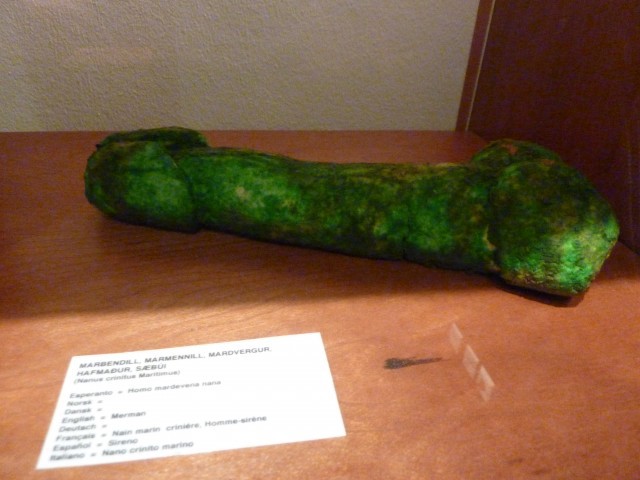
A merman penis.
The specimen that would prove most elusive for Hjartarson had nothing to do with the mythological, though. By the mid-2000s, Hjartarson had acquired the foreskin of a 40-year-old Icelander, as well as a 55-year-old Icelander’s testicles and epididymis (a tightly coiled tubular passage for sperm that sits atop the testes like a wig of ramen noodles). But he still wanted a whole human penis, with its shaft, balls and all.
In 2006, an elderly Icelandic man — a proud womanizer, according to Hjartarson — signed a letter pledging to donate his entire penis to the museum when he died. He passed away in January 2011. His penis now sits at the bottom of a glass jar of formaldehyde, but it bears little resemblance to typical members of its kind. It is grey, lumpy, wrinkled and sparsely covered in wiry pubic hairs; its tip seems to end abruptly, like a severed tree branch grown rough and knotty over time; its back end is an open mess of flesh and fat.
Hjartarson blames himself for the specimen’s unfortunate state. “When they called me and asked me what to do with it, I think I was drunk,” he told me on the phone in a hushed voice. “I said just put it in formaldehyde. We should have put it in water or vinegar. I should have stretched it or sewed it a little at the back.” He thinks that such preparations would have better preserved the original shape of the penis. “But we can always get a better one, a younger one, a bigger one,” he added. Three other men have promised to give their penises to the museum when they die: Peter Christmann, a German; John Dower, an Englishman; and Tom Mitchell, a rather unique American.
On his personal website (NSFW), Mitchell explains that he has loved his allegedly enormous penis from a very early age and has long thought of it as a remarkable toy to be enjoyed as much as possible. Admittedly, that might not distinguish him from most men, but Mitchell’s confidence evolved in an unusual way. After his wife nicknamed his penis Elmo and began to treat it as a living creature, Mitchell realized that his penis was indeed a kind of alien being attached to his body. Now, Mitchell is determined to share Elmo with everyone. “I want you to adopt him as yours,” he says on his website, “and to accept him as if he’s been attached to your body instead of mine.” Mitchell has resolved to remove his penis while he is still living, plastinate it and donate it to the Icelandic Phallological Museum. In the meantime, he sent a plaster mold of his organ to reserve his space.
The collection Hjartarson started more than 40 years ago will surely keep growing for the foreseeable future, but it may never be complete. ‘Completeness’ is not a particularly applicable concept in this situation. Even if the museum managed to collect a specimen from every single penis-wagging species known to science, there would still be thousands, perhaps millions, of undocumented species out there. Even in the twenty-first century, scientists find relatively large animals that they have never seen before, such as the Myanmar snub-nosed monkey and a new kind of slow loris, discovered in 2010 and 2012 respectively.
One penis that might bring the collection full circle, though, still hangs between the legs of the man who conceived of the museum in the first place. His son is committed to contributing, but Hjartarson himself is less certain. “It depends on who dies first,” he said, “me or my wife. If she dies first, the museum will get the specimen. If I die first, I can’t guarantee it.”
Ferris Jabr is an associate editor at Scientific American and a freelance writer based in New York.
New York City, February 27, 2013

★★ A dog turd on the rainy pavement was thinning out into a surrounding pool of color, like a glob of burnt-sienna acrylic on a palette. Dabs of it had been foot-painted up the sidewalk going east. The umbrella, tipped forward level to the ground, chattered in the headwind. The oppressive new scaffold on Broadway was welcome shelter. A woman pushed a stroller up onto the curb one-handed, the baby snug under plastic, while her other hand held a broken and flapping umbrella. A morning for the selfish brutes with oversized umbrellas to feel justified. There was no downtown skyline at all — and then, in midafternoon, there was Lower Manhattan again, shining in emergent sunlight, even as the mast of the Empire State Building still jabbed invisibly into gray clouds over midtown. The descent toward evening grew brighter and brighter. A man in a hoodie was out on a corner with a baby strapped to his chest. Pink clouds and blue sky shone in the puddles.
'Kilroy Was Here' Is 30
https://www.youtube.com/watch?v=Y0yTeUrCjms
It is almost impossible to make any kind of sweeping generational statements about significant moments in pop culture these days, but I think I can say with a fair degree of certainty that if you were ten years old when Styx’s Kilroy Was Here was released, you are 40 now. Think of all the choices you’ve made since! Anyway, let’s spend a second to pay tribute to an America where something like this
The album’s somewhat rock-operatic story tells of a future where rock music is outlawed by a fascist government and the “MMM (the Majority for Musical Morality)”. The story’s protagonist, Kilroy, is a former rock star who has been imprisoned by MMM leader Dr. Righteous. He escapes using a disguise (according to the album’s famous song “Mr. Roboto”) when he becomes aware that a young musician, Jonathan Chance, is on a mission to bring rock music back.
could sell over a million copies. Were we ever that young? Well, some of us were. And now we’re that much closer to death. Anyway, happy anniversary, music record from 1983!
"Too Much Like Reality": Writer Frank Bill On Violence, Meth And Work
by Rob Brunner

Have you ever gotten punched in the face? I have not. Nor have I ever punched anyone in the face, or seriously wanted to punch anyone in the face, or even been that close to many faces that were getting punched. The whole enterprise of face punching strikes me as both dumb and, if I’m honest, pretty terrifying. So I didn’t expect to spend much time with Frank Bill’s blood-sodden bone-crunch of a debut novel, Donnybrook (out March 5), one of the most unrepentantly, gleefully violent books I’ve ever come across. It’s about a bunch of loathsome redneck thugs who, while feuding over a stolen batch of meth, rendezvous at a backwoods bare-knuckle-fighting tournament to pummel each other into a heap of steaming mush. While that sounds like something no half-rational adult would ever want to slog through, it’s actually riveting stuff, mostly because Bill’s writing bleeds style and energy: there’s a kind of poetry in all the smashed skulls. “Wet dripped from the parted cartilage of his nose,” Bill writes. “Blotted and crusted onto flared lips. Ran down his butt-crack chin. Fertilized his crop of curled chest hair. A few teeth stuck to and stained his pink Izod shirt. Eldon’s tough talk had disappeared when the swelled slits of his eyes blinked back open.” And so on.
It turns out Bill is a forklift operator at a southern Indiana paint-additives plant, where he’s worked for almost 19 years. Donnybrook is his second book (after the well-received 2011 story collection Crimes in Southern Indiana). He gets up at 3:30 every morning to write as much as he can before heading to work around 7. In person, he’s actually a nice guy. Less so when he’s at the computer. “I’m not gonna ever write puppy dogs and ponies and the Care Bears,” he says. I called him one recent evening after his shift at the factory. Here’s what he had to say.
Rob Brunner: So Donnybrook is astonishingly violent. Why are you so interested in that kind of pain and anger and blood-splattering and cartilage crunching?
Frank Bill: Violence doesn’t bother me. I mean, grew up around hunting and skinning animals. That’s a violent ritual to eat food. Then there were the stories I grew up with about [someone a family member knew] who was a very violent man. He abused [various people] for about six years. I grew up around those stories — conversations about him coming home from work and shooting a dog or beating [someone] half the night, you know, not letting the kids eat anything. The other thing is just, when I was on [the night shift] I would read the paper every night. I was kind of like, man, look at this stuff. And then movies I like, things like Quentin Tarantino, they’re violent, but there’s a good story there. The old Clint Eastwood movies. Not that I’m a violent person, but those are the kinds of things that interest me. When I write something I want to put you in the scene. I want you to feel it, taste it and see it, and maybe even be repulsed by it.
The fighting in Donnybrook felt so much rougher to me than what you see in movies. Do you think people react differently to the violence in your writing than to movie and TV violence, which we’re maybe more numb to?
Probably people that didn’t like my books. [Laughs] But I understand what they’re saying. They’re like, “This is too much like reality.” Especially if you write about meth or the influence of drugs or alcohol on people. Well, then don’t read it! When I write, I don’t necessarily sit down and think about violence. I think a lot about language and character and movement. I wish sometimes people would pay more attention to how I write rather than what I write about. It’s not easy to sit there and come up with things. My stuff’s just not for everybody. I understand that.
I have to say, you seem like a pretty mellow dude. Are you secretly, like, a seething monster underneath the nice-guy exterior?
I mean, I have a temper, but I’m not really an angry person. Sometimes I sit down and write and I can release my frustration on the page. I am pretty laid back, but it’s kinda like, if push comes to shove then I’m pushing back, you know what I mean?
When was the last time you were in a fight?
I’ve never really actually been in a fight. I’ve never been in, like, a great big free-for-all or anything.
What about just a punch thrown at a bar or something?
Gosh, it’s probably been a long time ago. These guys, we used to [study martial arts] together and we used to go barhopping all the time. That’s probably back in 94, 95. You know how long a fight actually lasts is basically two or three movements: somebody reacts, the other person reacts, and it’s pretty much decided in that quick of a scenario. It’s just one of those things where somebody knows when to back off. If somebody makes you hurt, you’re not going to keep trying to do something.
What kind of research did you do for this book? Are there actual underground fighting events like the ones you describe?
There was a guy that studied [martial arts] with us, and I don’t know how much truth there is to this, but he would always talk about these underground fights. Of course, we never went to any of them, but that was something that always stuck in my head. The only research I did for this book — other than when I was younger and tried crystal meth — was I interviewed an ex-meth addict to get a [meth] recipe. He explained to me how they cooked it.
Wait, you tried crystal meth?
A guy I ran around with when I was in high school in the mid-90s used to get crystal meth in the mail. He’s dead now. He didn’t die from drugs or anything. He had a car wreck. We spent one entire week doing it. That’s the only time I’ve ever done it.
Did you like it?
Yeah, I can see how you can get addicted to it. But I didn’t get addicted to it. Every cigarette I lit it was like, man, this is the best damn cigarette I’ve ever had. It had that euphoria. It got your feel-goods going in your brain. It made you feel like Superman: everything you did was good. If I was gonna hug my girlfriend, it was probably the best hug I could get. My buddy and I went back to my house to go to sleep. I tried to lie in my bed for about and hour. I got up, and he was giggling. He was like, “You can’t sleep, can you?” I’m like, “no, I can’t sleep.” And he’s like, “Your heart feels like it’s gonna explode, don’t it?” I said, “Yeah.” He’s like, “Yeah, mine too!” God, it was horrible. I couldn’t sleep that first night. I’m like, “jeez, I don’t want to do this shit again.” It was a pretty wild week.
There’s obviously a lot of talk right now about violence in entertainment and to what extent it might be contributing to various horrific incidents. What do you make of that debate, and do you think there’s anything irresponsible about the kind of stories you’re telling?
I don’t see it that way. The more I look at the violence that happens, I’m kind of like, yeah, these kids watched a movie and you can blame it on that movie, but there’s something wrong in their perception of reality. There was already something wrong with that individual. They didn’t need to have a gun to begin with. I’ll probably get a lot of shit for saying this, but I’ve never been a big automatic-weapons fan. I grew up with a shotgun and a .22. It was for hunting. I have two handguns for protection. I’ve been around guns, and I’ve been picked on at school, too. But I’ve never wanted to just go out and murder people, you know? You’ve gotta know right from wrong. I don’t really have all the answers, but I don’t see myself as somebody that you point the finger at because [my work is] so violent. There’s a lot worse things than me, you know?

So you live in Corydon, Indiana. What’s that like?
I’ve always lived in Corydon. I was born and raised here in southern Indiana. It’s a small town. I grew up reading comic books, hanging out with my grandparents and my dad. My dad was always going hunting and helping my grandfather cut wood. They lived on a farm and didn’t have electric heat. My dad and grandfather hunted a lot. They hunted everything from squirrel to deer to rabbit. Of course my grandpa was also an avid coon hunter. I was a big rabbit and squirrel hunter.
What were you like in high school?
People always laugh at this, but I was kind of clean cut. I played basketball in elementary school, and then somewhere between fifth and sixth grade I started studying martial arts. I studied that until I was probably 16 or 17, at that age when kids start getting out and drinking and smoking and partying. I still had an interest in it, but I had other things I wanted to do.
Like drinking and smoking and partying?
Right. [Laughs] All that stuff.
Tell me about your day job. You work in a chemical plant?
Yeah, it’s a paint additives factory. I work in the warehouse. Basically, I load all the shipments up with a forklift. It’s basically driving in and out of a container when they back into your dock.
So how did you start writing?
I was never a big book reader when I was a kid. I could never find anything that really interested me. Probably around 1999 my wife and I went to see the movie Fight Club. I was blown away. In the credits it said it was based a book by Chuck Palahniuk. Of course, bookstores were sold out of it, so I bought his Invisible Monsters. I loved it. A lot of things that he would write about, the way he would coin sentences and things, it was just kind of like, “Man, you know, I’ve either said this or done this, or my friends have done it. He’s a guy that’s actually writing about it.” It made me think, well, I can write too.
Donnybrook has such a strong sense of place and a distinctive atmosphere, a lot of which comes from the way characters talk.
Basically, that’s how people speak around here. It’s a dialect. I’m sure I have a distinctive way that I speak. My words are rounded. It can sometimes come off like [I’m] a hick. Until I read somebody like [the late Mississippi author] Larry Brown I didn’t understand that you could write that way — that I could actually write where I was from.
Finally, tell me about that amazing cover. It hurts just looking at that thing.
I really didn’t have any input other than [FSG saying], “Here’s the cover. What do you think?”
What did you think?
I thought it was badass.
Rob Brunner is a writer and editor based in the New York area (okay, New Jersey). Follow him on twitter @IAmRobBrunner.
Science Finally Solves Riddle of Putting Eyeball On Tadpole's Tail
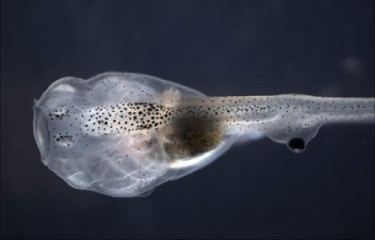
“If someone shouts ‘look behind you,’ tadpoles in Michael Levin’s laboratory may be ready. The tadpoles can see out of eyes growing from their tails, even though the organs aren’t directly wired to the animals’ brains.”
— If a scientist offers to put an eye in your butt, and you’re a tadpole, then it’s probably legit.
Photo by D. Blackiston and M. Levin/Tufts University.
Rude Twitter User @Pontifex Ignores Best Practices, Issues Alleged "Last Tweet"

Micro-blogging service Twitter struggles with corporate and celebrity users who refuse to follow industry standards for social media engagement. Case in point: Twitter user @Pontifex, apparently an elderly World War II veteran with an inexplicably large online following, has outraged millions of Twitter users by refusing to follow anyone but his own duplicate accounts. The rudeness reached such a point today that the end-user has finally given in to intense pressure to retire his Twitter accounts and also give up his job leading a global pedophilia ring headquartered in a European castle.
But there is a #fail even with this alleged cessation of the @Pontifex Twitter account, which was widely reported to be shutting down today with the removal of the account owner, Joseph Ratzinger of Bavaria. The board of directors at Ratzinger’s organization now claims the account will not be shut down, and that Ratzinger’s successor may wind up using it for whatever purposes. Social media engagement experts say that while it is extremely unprofessional to lie about shutting down a Twitter account, it is also questionable practice to abandon more than 2 million Twitter followers.
Monsignor Paul Tighe, Secretary of the Pontifical Council for Social Communications, confirmed in an email that the account will hibernate, not close, until the new pope is chosen. “During the period between today and the election of new pope the account will be inactive,” he wrote, “not shut down.”
It will then be up to the new pope to decide whether or not to keep the account running. “Obviously we leave all decisions to the new man,” wrote Tighe. “But we would hope that he might continue to use @Pontifex, which would maintain continuity.”
Technology journalists note that it costs about $5 for 20,000 followers, so Ratzinger’s organization may have spent as much as $125 to collect the 2.5 million Twitter followers of the @Pontifex account, if the followers were indeed purchased.
Twitter is headquartered in San Francisco and reported earnings of $259.9 million in calendar year 2012.
UPDATE: The Vatican has now deleted all the ex-pope’s tweets. This is the modern version of crucifying somebody upside down, which is how the first pope (St. Peter) was dismissed of His duties.
B. Martin, "The SUNY Anthem"
“SUNY paid him $3,000 to ‘partially supplement the artist’s production costs for the music video.’ The ‘SUNY Anthem’ will be incorporated into broader marketing and outreach efforts, Doyle said.The video carries the official SUNY logo and Martin says to look for him on a SUNY tour. According to his website, some of his other ballads include ‘Drippin’ Wet’ and ‘Shake it from Behind.’”
— Thanks a lot, Drake. This is your fault, you know. [Related.]
